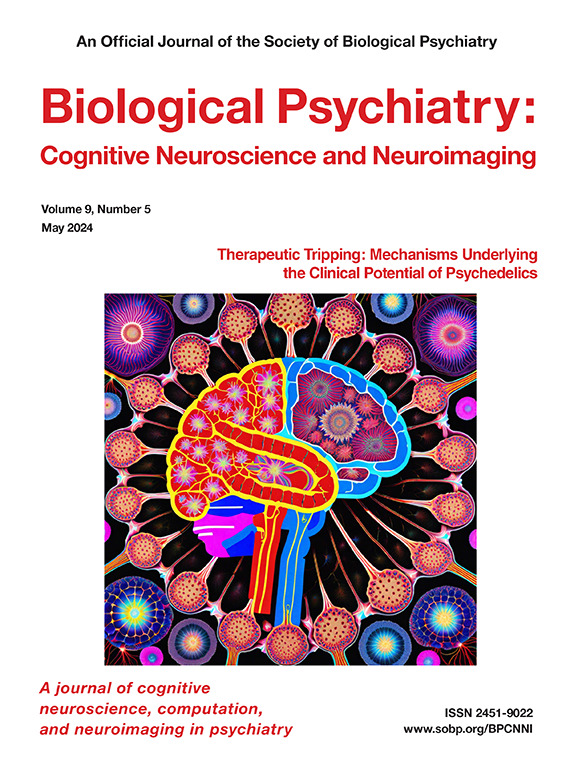Mitochondria and Cognition: An [18F]BCPP-EF Positron Emission Tomography Study of Mitochondrial Complex I Levels and Brain Activation During Task Switching
IF 4.8
2区 医学
Q1 NEUROSCIENCES
Biological Psychiatry-Cognitive Neuroscience and Neuroimaging
Pub Date : 2025-08-01
DOI:10.1016/j.bpsc.2025.02.007
引用次数: 0
Abstract
Background
Mitochondrial complex I is the largest enzyme complex in the respiratory chain and can be noninvasively measured using [18F]BCPP-EF positron emission tomography (PET). Neurological conditions associated with mitochondria complex I pathology are also associated with altered blood oxygen level–dependent (BOLD) response and impairments in cognition. In this study, we aimed to investigate the relationship between mitochondrial complex I levels, cognitive function, and associated neural activity during task switching in healthy humans.
Methods
Cognitively healthy adults (N = 23) underwent [18F]BCPP-EF PET scans and functional magnetic resonance imaging (fMRI) while performing a task-switching exercise. Task performance metrics included switch cost and switching accuracy. Data were analyzed using linear mixed-effects models and partial least squares regression (PLS-R).
Results
We found significant positive associations between [18F]BCPP-EF volume of distribution (VT) and the task-switching fMRI response (β = 3.351, SE = 1.01, z = 3.249, p = .001). Positive Pearson’s correlations between [18F]BCPP-EF VT and the fMRI response were observed in the dorsolateral prefrontal cortex (r = 0.61, p = .0019), insula (r = 0.46, p = .0264), parietal precuneus (r = 0.51, p = .0139), and anterior cingulate cortex (r = 0.45, p = .0293). [18F]BCPP-EF VT across task-relevant regions was associated with task switching accuracy (PLS-R, R2 = 0.48, root mean square error [RMSE] = 0.154, p = .011) and with switch cost (PLS-R, R2 = 0.38, RMSE = 0.07, p = .048).
Conclusions
Higher mitochondrial complex I levels may underlie an individual’s ability to exhibit a stronger BOLD response during task switching and are associated with better task-switching performance. This provides the first evidence linking the BOLD response with mitochondrial complex I and suggests a possible biological mechanism for the aberrant BOLD response in conditions associated with mitochondrial complex I dysfunction that should be tested in future studies.
线粒体让你思考:一项[18F]BCPP-EF正电子发射断层扫描研究线粒体复合体I水平和任务转换过程中的大脑激活。
背景:线粒体复合体I是呼吸链中最大的酶复合体,可以使用[18F]BCPP-EF正电子发射断层扫描(PET)无创测量。与线粒体复合体I病理相关的神经系统疾病也与血氧水平依赖性(BOLD)反应的改变和认知障碍有关。本研究旨在探讨健康人在任务转换过程中线粒体复合体I水平、认知功能和相关神经活动之间的关系。方法:认知健康的成人(n=23)在进行任务转换练习时进行了[18F]BCPP-EF PET扫描和功能磁共振成像(fMRI)。任务性能指标包括切换成本和切换精度。数据分析采用线性混合效应模型和偏最小二乘回归(PLS-R)。结果:我们发现[18F]BCPP-EF VT与任务转换fMRI反应呈显著正相关(β=3.351, SE=1.01, z=3.249, p=0.001)。[18F]BCPP-EF VT与fMRI反应在背外侧前额叶皮层(r=0.61, p=0.0019)、脑岛(r=0.46, p=0.0264)、顶叶-楔前叶(r=0.51, p=0.0139)和前扣带皮层(r=0.45, p=0.0293)均呈Pearson正相关。[18]跨任务相关区域的BCPP-EF VT与任务切换精度(PLS-R, R2=0.48, RMSE=0.154, p=0.011)和切换成本(PLS-R, R2=0.38, RMSE=0.07, p=0.048)相关。结论:较高的线粒体复合体I水平可能是个体在任务转换过程中表现出更强的BOLD反应能力的基础,并与更好的任务转换表现相关。这提供了将BOLD反应与线粒体复合体I联系起来的第一个证据,并提出了与线粒体复合体I功能障碍相关的异常BOLD反应的可能生物学机制,应该在未来的研究中进行测试。
本文章由计算机程序翻译,如有差异,请以英文原文为准。
求助全文
约1分钟内获得全文
求助全文
来源期刊

Biological Psychiatry-Cognitive Neuroscience and Neuroimaging
Neuroscience-Biological Psychiatry
CiteScore
10.40
自引率
1.70%
发文量
247
审稿时长
30 days
期刊介绍:
Biological Psychiatry: Cognitive Neuroscience and Neuroimaging is an official journal of the Society for Biological Psychiatry, whose purpose is to promote excellence in scientific research and education in fields that investigate the nature, causes, mechanisms, and treatments of disorders of thought, emotion, or behavior. In accord with this mission, this peer-reviewed, rapid-publication, international journal focuses on studies using the tools and constructs of cognitive neuroscience, including the full range of non-invasive neuroimaging and human extra- and intracranial physiological recording methodologies. It publishes both basic and clinical studies, including those that incorporate genetic data, pharmacological challenges, and computational modeling approaches. The journal publishes novel results of original research which represent an important new lead or significant impact on the field. Reviews and commentaries that focus on topics of current research and interest are also encouraged.
 求助内容:
求助内容: 应助结果提醒方式:
应助结果提醒方式:


